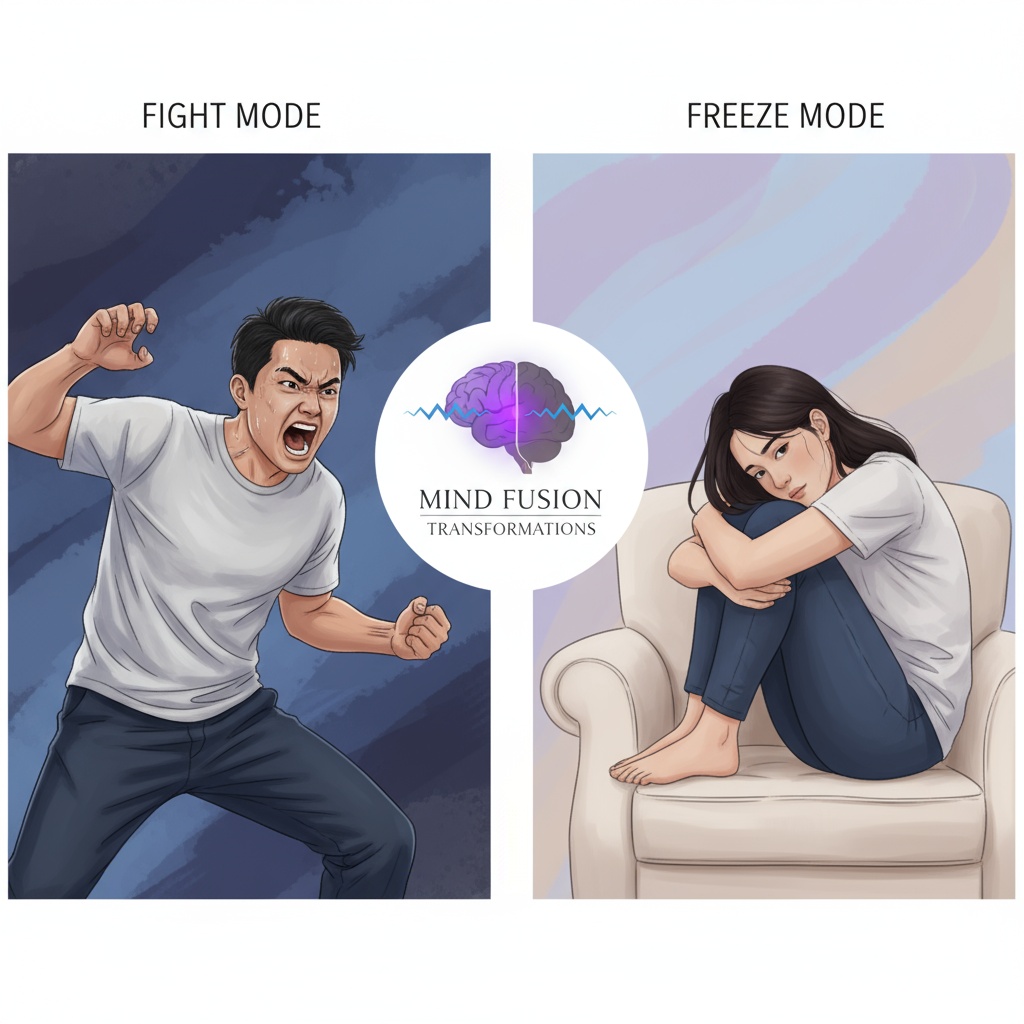5 Signs Your Nervous System Is Stuck in Survival Mode (And What to Do About It)
Oct 23, 2025
You wake up exhausted even though you slept eight hours.
Your shoulders are permanently hunched toward your ears.
The smallest conflict feels like a life-or-death situation.
You're achieving, performing, succeeding—and yet you feel like you're barely surviving.
If this sounds familiar, you're not alone. And more importantly: you're not broken.
Your nervous system is stuck in survival mode. And it's trying to tell you something.
What Does "Survival Mode" Actually Mean?
Your autonomic nervous system has one primary job: keep you alive.
When it detects danger (real or perceived), it activates one of three survival responses:
- Fight: Aggression, anger, confrontation
- Flight: Anxiety, restlessness, always needing to escape
- Freeze: Shutdown, numbness, disconnection
These responses are brilliant in actual emergencies. The problem? For many of us—especially those who experienced childhood trauma, chronic stress, or relational wounding—our nervous systems learned to treat everything as an emergency.
So we live in a constant state of activation. Even when we're objectively safe.
Even when life is actually going well.
Your body is still braced for impact.

Sign #1: You Can't Relax (Even When You Try)
What it looks like:
You can't sit still without feeling anxious or restless
"Doing nothing" feels impossible or wrong
Your mind races the moment you try to rest
Vacations don't actually help—you come back just as exhausted
You feel guilty for not being productive
What's actually happening:
This is hypervigilance—a sympathetic nervous system response. Your body is stuck in "scan for danger" mode. Rest feels unsafe because your nervous system believes that letting your guard down means something bad will happen.

What your nervous system needs:
Gentle, grounding practices that signal safety. Start with 5 minutes of conscious breathing daily—inhale for 4 counts, hold for 4, exhale for 6. The longer exhale activates your parasympathetic nervous system (rest mode).
Sign #2: You're Always Tired (No Matter How Much You Sleep)
What it looks like:
- You sleep 7-9 hours but wake up feeling like you didn't sleep at all
- You need multiple cups of coffee just to function
- You're exhausted but can't fall asleep or stay asleep
- Rest doesn't actually restore you
- You feel like you're running on fumes
What's actually happening:
Your nervous system never fully turns off. Even when you're sleeping, your body is in a low-level state of activation. You might be lying down, but your system is still "on duty." This leads to nervous system depletion—your body is working overtime even at rest.

What your nervous system needs:
Evening wind-down rituals that help your body transition from "doing" to "being." Try a warm bath, gentle stretching, or a body scan meditation before bed. The goal is to teach your body that nighttime = safety.
Download my free 5-Minute Nervous System Reset" audio practice
Sign #3: You Overreact or Shut Down in Conflict
What it looks like:
- Small disagreements escalate into big fights
- You go from 0 to 100 in seconds—rage, panic, or defensiveness
- Or the opposite: you completely shut down, go silent, can't access words
- You feel hijacked by your emotions
- Later, you think "why did I react that way?"
What's actually happening:
When your nervous system perceives conflict as danger, it bypasses your thinking brain (prefrontal cortex) and activates your survival brain (amygdala). You're either in fight mode (anger, aggression) or freeze mode (shutdown, dissociation). You're not choosing these responses—your nervous system is.

What your nervous system needs:
Co-regulation practices and tools for staying in your "window of tolerance." Before reacting in conflict, pause and take 3 deep breaths. Place your hand on your heart. Ask yourself: "Am I actually in danger, or does this just feel like danger?"
Over time, you're teaching your nervous system that conflict ≠ threat.
Sign #4: You Feel Disconnected from Your Body
What it looks like:
- You live "in your head"—overthinking everything
- You don't feel your emotions; you analyze them
- You're disconnected from physical sensations (hunger, fullness, pain)
- You feel numb or "checked out" most of the time
- People say you seem distant or unavailable
What's actually happening:
This is dorsal vagal shutdown—a freeze response. When life felt too overwhelming (often in childhood), your nervous system learned to dissociate as a survival mechanism. You "left your body" to cope. The problem is, this pattern becomes automatic—even when you're safe now.

What your nervous system needs:
Embodiment practices that help you come back into your body gently. Start with simple body awareness: feel your feet on the ground, notice your breath, place your hands on your belly. You're teaching your body: "It's safe to be here now."
Somatic practices, dance, yoga, or even just walking barefoot on grass can help you reconnect.
Sign #5: You Repeat the Same Relationship Patterns
What it looks like:
- You keep attracting unavailable or emotionally distant partners
- You people-please until you're resentful
- You have terrible boundaries (or overly rigid ones)
- You "know better" but keep doing the same thing
- Your relationships feel exhausting or one-sided
What's actually happening:
Your nervous system is running on subconscious programming from your earliest relationships. If love felt conditional, unsafe, or inconsistent growing up, your nervous system learned: "This is what love feels like." So even though you consciously want healthy love, your system gravitates toward what's familiar—even if it's painful.

What your nervous system needs:
Re-patterning work at the subconscious level. This is where breathwork, hypnosis, and somatic therapy become essential. You can't think your way out of subconscious patterns—you have to rewire them at the body level.
Take the Inner Sanctuary Quiz to discover which "room" of your inner world needs healing first
What Now? How to Start Healing Your Nervous System
If you recognized yourself in multiple (or all) of these signs, take a breath. You're not broken. You're dysregulated. And dysregulation can be healed.
Here's where to start:
1. Get Clear on Where You Are
Take my free Inner Sanctuary Quiz. It's a 3-minute assessment that helps you identify which area of your nervous system needs attention first. You'll get personalized results and a practice to start regulating today.
2. Learn Regulation Tools
Your nervous system needs daily support. Download my 5-Minute Nervous System Reset audio practice. It's a simple breathwork + grounding exercise you can do anytime you feel activated.
3. Do Deeper Work
If you're ready to move beyond surface-level coping and actually rewire your nervous system at the body level, I offer 1:1 Hypno-Breath Fusion™ sessions.
This is 90 minutes of intensive, body-level healing where we use breathwork, hypnosis, and somatic integration to release what's keeping you stuck.
Most clients feel a major shift in their first session—like they can finally breathe deeply, old triggers don't activate them the same way, or they feel safe in their body for the first time in years.
The Truth About Healing
Here's what I want you to know:
Healing your nervous system doesn't mean you'll never feel stressed, never get triggered, never have a hard day.
It means your body will know how to return to safety instead of getting stuck in survival.
It means you'll have the tools to regulate yourself instead of being hijacked by your reactions.
It means you'll finally feel at home in your own body.
And you don't have to do this alone.
You're Not Broken. You're Stuck. And We Can Unstick You.
Your nervous system learned to protect you. It kept you alive. It did its job beautifully.
But the danger has passed. And now it's time to teach your body that it's safe to rest. To connect. To heal.
That's the work. And I'd be honored to guide you through it.
About the Author:
Erica Carter-Folk is the creator of the Hypno-Breath Fusion™ Method and the Inner Sanctuary™ Journey. She helps high-functioning adults heal nervous system trauma and finally feel safe in their bodies after years of surviving. Learn more at mind-fusion.com or follow her on Instagram @mindfusioncoach.
Stay connected with news and updates!
Join our mailing list to receive the latest news and updates from our team in our weekly newsletter.
Don't worry, your information will not be shared.
We hate SPAM. We will never sell your information, for any reason.




